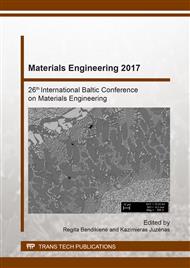p.185
p.190
p.195
p.201
p.207
p.212
p.219
p.224
p.229
Influence of Air Plasma Spraying Process Parameters on Ceramic Layer in Thermal Barrier Coatings
Abstract:
The aim of this study was to examine the possibility of application in APS process Yttria Stabilized Zirconia (YSZ) – Metco 6700 ceramic powder normally used in Low Pressure Plasma Spraying (LPPS) method. Powder grain size is around 10 µm. Parameters such as chemical composition of plasma gases and current were changed to obtain the best result. The experiment was divided into two stages. Firstly, temperature, velocity and size of a molten particle of ceramic powder inside plasma plume were measured via DPV eVolution equipment (TECNAR company) during a different set of process parameters. Plasma plume was also scanned to obtain cross-section contour plots of mentioned properties of the molten particle. Secondly, the same processes were repeated to deposit TBC coatings onto sheet metal to examine the structure.The obtained results showed that it is possible to use fine-grain YSZ powder Metco 6700 for APS process. Obtained ceramic coatings had a thickness from 100 to 240 µm. The plasma sprayed coating was characterised by a smooth surface. The measurement of spraying parameters showed the uniform temperature, velocity and particle size of the powder inside plasma plume.
Info:
Periodical:
Pages:
207-211
Citation:
Online since:
October 2017
Authors:
Price:
Сopyright:
© 2017 Trans Tech Publications Ltd. All Rights Reserved
Share:
Citation:


